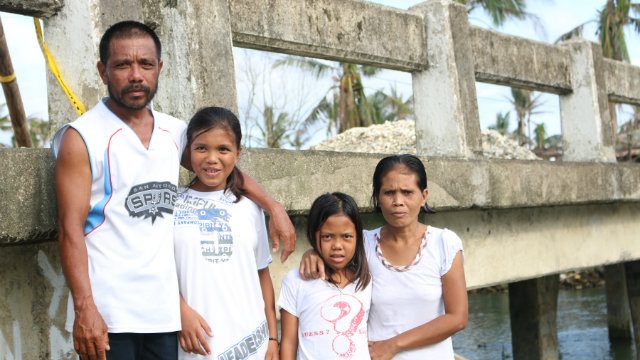SUMMARY
This is AI generated summarization, which may have errors. For context, always refer to the full article.

EASTERN SAMAR, Philippines – “At first, we couldn’t sleep. Every time there’s a car, it feels like there’s an earthquake. I was afraid. Even today, when there are big cars, I still feel nervous.”
Evelyn, who is 12 years old, is talking about her family’s makeshift house built under a bridge in village in Eastern Samar. Her father, Justo, was both shy and teary-eyed when he heard his daughter.
“I didn’t want this to happen. I wanted to give them proper shelter after the typhoon took our house, but I felt helpless. My income is not even enough for our food,” he said.
Justo is a fisherman whose income is only P500 per week. He has 8 children, 4 of whom re still living with him. He used the remainders of his old house to build his new makeshift home under the bridge.
“The materials I salvaged are not enough to spare us from the rain. At least under the bridge, we won’t easily get drenched,” he said.
Typhoon Ruby (international name Hagupit) slammed Eastern Philippines, churning across Eastern Visayas and Bicol Region on December 6, 2014. With winds reaching 220 kilometers per hour, Ruby claimed 27 lives – 21 from Eastern Samar. The damage to crop and agricultural infrastructures was pegged at P1 billion, according to the Department of Agriculture.
World Vision immediately deployed assessment teams in the affected areas as soon as the roads were accessible. Emergency essentials like food, shelter kits, non-food items, water and jerry cans were also distributed to more than 5,000 of the worst-affected families.
“We are grateful, especially for the shelter kit and food that we received. I must admit that when Papa told us that we were moving under the bridge, I was ashamed to let my classmates know about our condition. In the end, I realized how my father is working hard for us and was sorry for feeling such shame,” Evelyn admitted.
The family has been living under the bridge for more than a month now including Christmas and new year. When subsequent Tropical Storm Seniang (Jangmi) and Amang (Mekkhala) threatened the Philippines yet again, they evacuated to a safer area.
“I asked them to evacuate because the river might overflow. I stayed because I needed to look after our things. Those kinds of situations sometimes make me feel frustrated. I’m a father and it pains me seeing my children cringe in fear. I know I must keep working harder for my family,” said Justo.
Aside from the emergency essentials they received in December, Justo is one of the 3,250 cash-for-work beneficiaries. He is about to commence 15 half days of work to earn P3,900 at the end of the program.
“This money will be a huge help to us. I plan to use part of it for our house. Thank you so much,” expressed Justo.
Evelyn is hoping that they will be able to leave their life under the bridge soon.
“I hope we can have our house back. It’s not big but I feel more at home there,” She said. – Rappler.com
Joy Maluyo, 25, is currently deployed in Visayas as a Communication Officer for World Vision’s Haiyan Response. She holds an MA in Development Communication from University of the Philippines Open University.
Add a comment
How does this make you feel?
There are no comments yet. Add your comment to start the conversation.